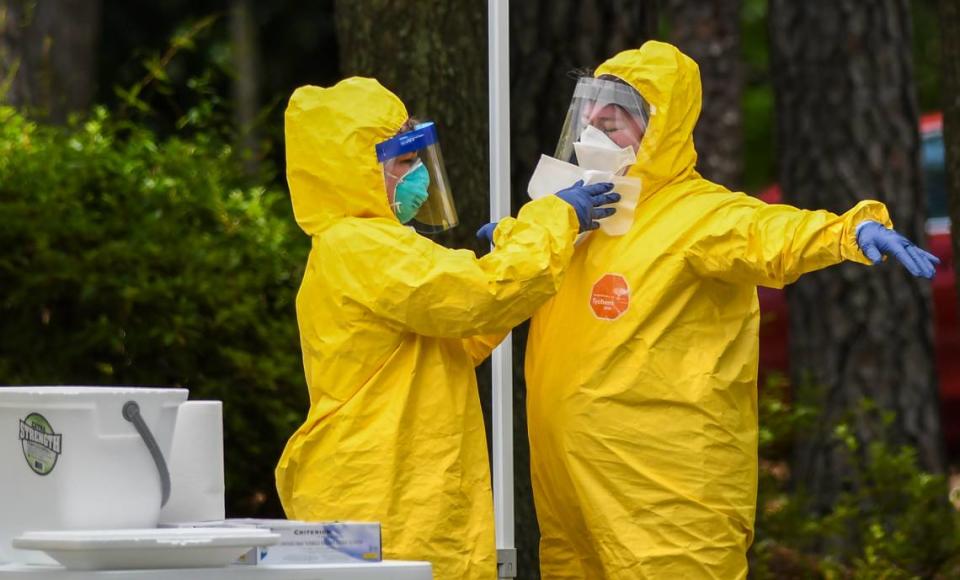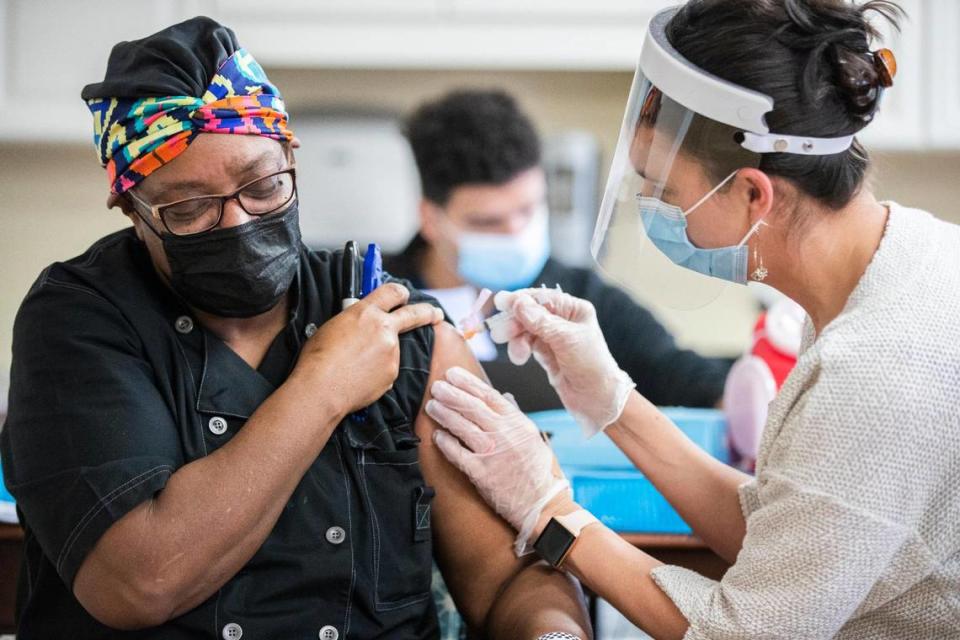The ‘hidden’ toll: Hundreds of COVID-19 deaths possibly went unreported in SC, study says
Hundreds of COVID-19 deaths in South Carolina may have gone unreported in 2020, according to a new study that examined last year’s surge of unexpected fatalities in the Palmetto State.
A team of researchers at Boston University and the University of Pennsylvania recently estimated that, based on historic mortality data, over 6,800 unexpected deaths occurred around the state last year.
The majority of those deaths were labeled as COVID-19 fatalities, but about 1,559 of them were attributed to other causes, according to the team’s estimates. The study, a preprint paper, was published to medRxiv in late May.
Coronavirus deaths that were misidentified — and other fatalities that were indirectly caused by the pandemic’s economic and social upheaval — probably accounted for many of the extra 1,559 deaths, said Andrew Stokes, the study’s senior author.
The study provides a more complete picture of COVID-19’s devastating impact in South Carolina last year and offers a glimpse into the pathogen’s concealed toll in rural parts of the state, Stokes said.
The team’s findings, Stokes added, could help public health officials convince wary residents to get vaccinated.
“People respond to the information they have,” he said, “and if there are counties in which the pandemic is effectively hidden, because the deaths are being underreported, people are unlikely to take the pandemic with proper seriousness.”
Unexpected deaths spiked as the coronavirus spread
Stokes’ team analyzed county-level mortality data from the National Center for Health Statistics to estimate “excess death” rates in local communities across the United States.
The researchers used nine years of federal data to predict how many deaths of all causes were expected per county in 2020, then compared those numbers to each county’s actual death toll.
The team was later able to calculate, in every S.C. county, the number of unexpected deaths that were not classified as COVID-19 fatalities. Researchers subtracted the number of coronavirus deaths per county from the number of estimated excess deaths. There were over 5,500 COVID-19 deaths statewide in 2020, the team reported. (Stokes and his colleagues documented unexpected deaths around the country, from California to New York and everywhere in between. South Carolina was no exception.)
That’s how Stokes’ team identified the roughly 1,559 excess deaths in the Palmetto State that were not attributed to COVID-19, he said.
Some of those deaths, he said, could have been COVID-19 fatalities that ultimately flew under the radar because of limited coronavirus testing early last spring.
Other COVID-19 deaths may have been mistaken as fatalities caused only by Alzheimer’s disease, heart disease, diabetes or other illnesses, Stokes said.
(COVID-19 can trigger various issues in the body that directly lead to a person’s death. The disease, for example, might cause pneumonia in a patient who then becomes severely ill due to an underlying condition like hypertension.)

Lior Rennert, a biostatistician at Clemson University who was not involved in Stokes’ study, said he doubts that anyone intentionally failed to report COVID-19 deaths last year.
But it wouldn’t surprise Rennert if coronavirus fatalities were, in fact, undercounted. People were initially unfamiliar with COVID-19’s clinical presentation, among other things, he said. (Derrek Asberry, a spokesperson for the S.C. Department of Health and Environmental Control, in a Thursday statement wrote that the agency “can’t speculate at this time as to the number of unreported COVID-related deaths there could be for the state.”)
“It’s never, like, COVID itself that kills. It’s what COVID does to your body and your organs that eventually can lead to death,” Rennert said.
The pandemic may have also contributed to South Carolina’s unexpected death toll in indirect ways, the biostatistician agreed.
That issue, of course, is hard to quantify. But some experts have argued that an increase in depression and isolation could have factored into any number of unexpected deaths last year, especially given the economic downturn in March 2020.
Take, as an example, the state’s spike in fatal drug overdoses.
South Carolina as of November had recorded 1,667 overdose deaths over the past 12 months, according to provisional data from the Centers for Disease Control and Prevention. That’s a 47.1% increase year-over-year.
Similar overdose figures have been reported around the country.
“The disruption to daily life due to the COVID-19 pandemic has hit those with substance use disorder hard,” wrote Dr. Robert Redfield, the former CDC director, in a December statement.

The pandemic could have also influenced a surge in violent crime, one coroner said.
“The homicides were probably up 100% from what we normally have here,” said Calhoun County Coroner Donnie Porth, “and that may have been because everybody is depressed, everybody is anxious, for one reason or another.”
The state reported 571 murders in 2020, marking a 24.9% increase over the 457 murders in 2019, according to the S.C. Law Enforcement Division.
The coronavirus had hidden effects in rural areas
Rural counties in South Carolina saw the state’s highest rates of unexpected deaths that were not identified as COVID-19 fatalities, mirroring a national trend that Stokes’ team discovered.
Saluda, Dillon, Newberry, Clarendon and Edgefield counties topped the state’s list.
Rennert, of Clemson University, noted that some rural areas generally had lower coronavirus testing rates last year. Saluda County, for example, as of late December had a rate of about 446 tests conducted per 10,000 people, the lowest rate in South Carolina at the time.
“COVID cases themselves (are) already underrepresented,” Rennert said, “because there’s less testing. ... It’s not inconceivable that, because of that,” coronavirus fatalities were underreported, too.
The Saluda County coroner did not respond to a phone message Wednesday, but other coroners argued that the study’s findings probably reflected COVID-19’s indirect effects, opposed to testing issues.
David Burnett, the coroner for Edgefield County, where there’s just over 26,900 residents, said that mental and psychological impacts last year could have played a role in his county’s “upswing” in deaths, including in nursing homes.
“You maybe give up when you haven’t been able to see your families. ... Everything was locked down,” Burnett said. “You couldn’t go anywhere and you couldn’t do anything.”
He added that his office never had any trouble in securing COVID-19 tests for bodies. “I can’t really say that ‘lack of testing’ did anything,” he said.

Porth, of Calhoun County, meanwhile, agreed with Burnett. Calhoun County has roughly 14,600 residents.
“If there was an autopsy done, just to protect the forensic pathologist, we would do testing,” Porth said.
“My traffic fatalities went down, and I attributed that to less travel on the interstate,” he added, “but my suicides went up, and then everything else — the medical issues, the cancer, the heart conditions and such as that — all of that went up appropriately. ... Nothing really stood out as being one of the contributing factors to COVID.”
Vaccine hesitancy could be addressed
Stokes, who’s an assistant professor at the Boston University School of Public Health, said excess mortality analyses could help convince wary residents to roll up their sleeves for a dose of Pfizer-BioNTech, Moderna or Johnson & Johnson’s vaccines.
That kind of help is sorely needed in South Carolina.
The Palmetto State’s inoculation rate has been lagging for weeks. Only about 46.5% of S.C. residents 12 or older have received at least one dose. And the state’s adult vaccination rate is among the lowest in the country.
Some residents are still suspicious of the shots because of their speedy development last year. Others attribute their vaccine hesitancy to political beliefs or conspiracy theories.
The study of unexpected deaths and the accurate reporting of coronavirus fatalities, though, could prove to vaccine skeptics that COVID-19’s severity has been understated, motivating them to get a jab, Stokes said.
“There’s a very clear feedback loop between mortality statistics and behavior,” Stokes said.
Note: Vaccine data in this story are current as of Friday morning.


 Yahoo Movies
Yahoo Movies 
